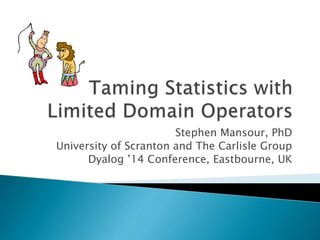
TamingStatistics
- 1. Stephen Mansour, PhD University of Scranton and The Carlisle Group Dyalog ’14 Conference, Eastbourne, UK
- 2. Many statistical software packages out there: Minitab, R, Excel, SPSS Excel has about 87 statistical functions. 6 of them involve the t distribution alone: T.DIST T.INV T.DIST.RT T.INV.2T T.DIST.2T T.TEST R has four related functions for each of 20 distributions resulting in a total of 80 distribution functions alone
- 3. Defined Operators! How can we exploit operators to reduce the explosive number of statistical functions? Let’s look at an example . . .
- 4. Typical attendance is about 100 delegates with a standard deviation of 20. Assume next year’s conference centre can support up to130 delegates. What are the chances that next year’s attendance will exceed capacity?
- 5. =1-NORM.DIST(130,100,20,TRUE) Now let’s use R-Connect in APL: +#.∆r.x 'pnorm(⍵,⍵,⍵,⍵)' 130 100 20 0 Wouldn’t it be nice to enter: 100 20 normal probability > 130 100 20 (normal probability >) 130
- 6. normal probability < 1.64 100 20 normal probability between 110 130 5 0.5 binomial probability = 2 7 tDist criticalValue < 0.05 5 chiSquare randomVariable 13 mean confidenceInterval X (SEX='F') proportion hypothesis ≥ 0.5 GROUPA mean hypothesis = GROUPB variance theoretical binomial 5 0.2
- 7. Summary Functions ◦ Descriptive Statistics Probability Distributions ◦ Theoretical Models Relations
- 8. Summary functions are of the form: 𝑦 = 𝑓 𝑥1, 𝑥2, … 𝑥 𝑛 They produce a single value from a vector. Structurally they are equivalent to g/ where g is a scalar function and the right argument is a simple numeric vector. A statistic is a summary function of a sample; a parameter is a summary function of a population.
- 9. Examples ◦ Measures of central tendency: mean, median, mode ◦ Measures of Spread variance, standard deviation, range , IQR ◦ Measures of Position min, max, quartiles, percentiles ◦ Measures of shape skewness, kurtosis
- 10. Probability Distributions are functions defined in a natural way when they are called without an operator: ◦ Discrete: probability mass function ◦ Continuous: density function Left argument is parameter list Right argument can be any value taken on by the distribution. Probability Distributions are scalar with respect to the right argument.
- 11. Discrete Distributions Parameter List uniform a - lower bound (default 1), b - upper bound. binomial n - Sample size, p - probability of success poisson λ - average number of arrivals per time period negativeBinomial n - number of success, p - probability of success hyperGeometric m - number of successes , n - sample size , N - Population size multinomial V - List of Values (default 1 thru n), P - List of probabilities totaling 1
- 12. Continuous Distributions Parameter List normal μ - theoretical mean (default 0); σ - standard deviation (default 1) exponential λ - mean time to fail rectangular (continuous uniform) a - lower bound (default 0), b - upper bound (default 1) triangular a - lower bound, m - most common value, b - upper bound chiSquare df - degrees of freedom tDist (Student) df - degrees of freedom fDist df1 - degrees of freedom for numerator, df2 - degrees of freedom for denominator
- 13. Relational functions are dyadic functions whose range is {0,1} 1=relation is satisfied, 0 otherwise. Examples: < ≤ = ≥ > ≠ ∊ between←{¯1=×/×⍺∘.-⍵}
- 14. By limiting the domain of an operator to one of the previously-defined functional classifications, we can create an operator to perform statistical analysis. For a dyadic operator, each operand can be limited to a particular (but not necessarily the same) functional classification.
- 15. Operator Left Operand Right Operand probability Distribution Relation criticalValue Distribution Relation confidenceInterval Summary N/A hypothesis Summary Relation goodnessOfFit Distribution N/A randomVariable Distribution N/A theoretical Summary Distribution running Summary N/A
- 16. Most functions and operators can easily be written in APL. Internals not important to user R interface can be used if necessary for statistical distributions. Correct nomenclature and ease of use is critical.
- 17. A sample can be represented by raw data, a frequency distribution, or sample statistics. The following items are interchangeable as arguments to the limited domain operators above: Raw data: Vector Frequency Distribution: Matrix Summary Statistics: PropertySpace
- 18. Matrix: Frequency Distribution Namespace: Sample Statistics D 2 0 3 4 3 1 0 2 0 4 ⎕←FT←frequency D 0 3 1 1 2 2 3 2 4 2 mean D 1.9 variance D 2.5444 PS←⎕NS '' PS.count←10 PS.mean←1.9 PS.variance←2.544
- 19. )LOAD TamingStatistics ◦ All APL version )LOAD TamingStatisticsR ◦ Third party – Must install R (Free)
- 20. There are many statistical packages out there; some, like R can be used with APL Operator syntax is unique to APL R can be called directly from APL using RCONNECT, but APL operator syntax is easier to understand.